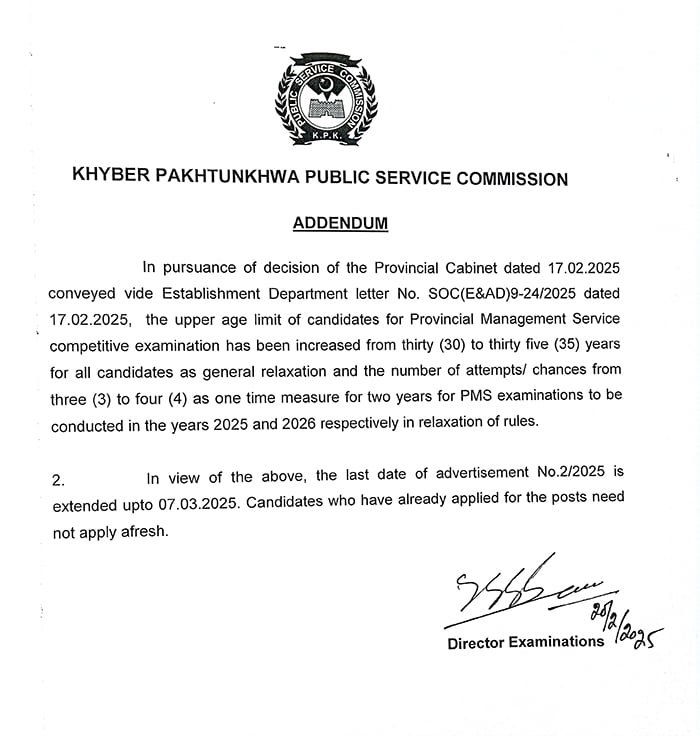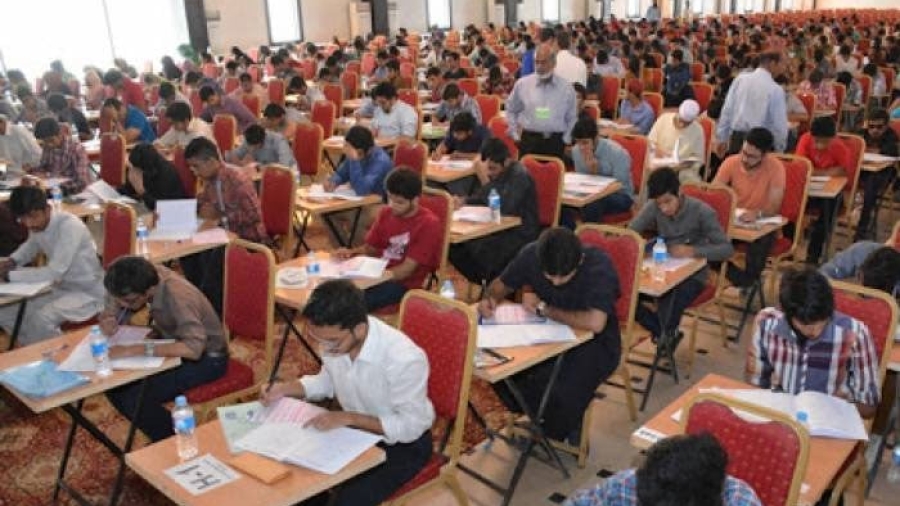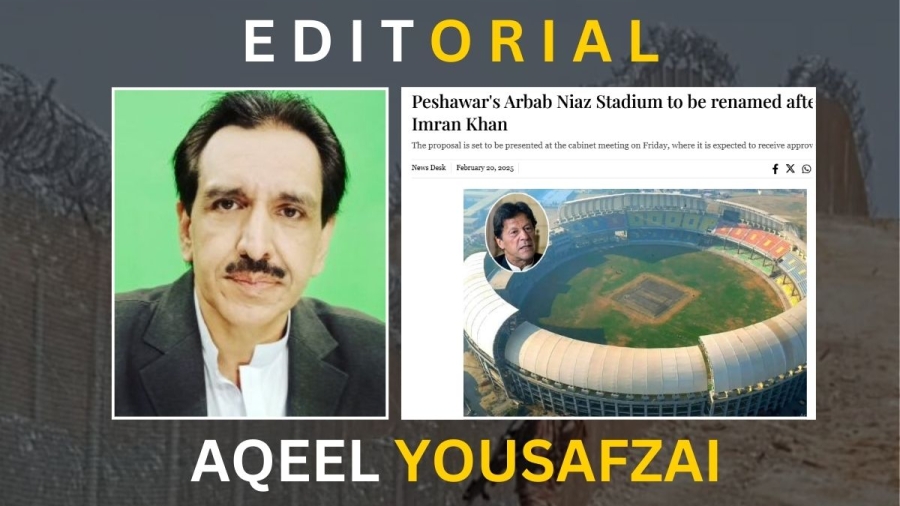یونیورسٹی آف لکی مروت نے وویمن یونیورسٹی مردان کے ساتھ مل کر کامسٹیک اسلام آباد میں پائیدار ترقی کے ہدف پر 09 ویں بین الاقوامی کانفرنس کا انعقاد کیاگیا۔ گزشتہ روز ایک تقریب منعقد ہوئی۔جس میں چیئرمین سینیٹ کی قائمہ کمیٹی برائے موسمیاتی تبدیلی سنیٹر شیری رحمان نے بحیثیت مہمان خصوصی شرکت کی جبکہ دیگر مہمانوں میں ازبک سفارتخانے کےاعزازی علیشیر تختائیف، محترمہ فرح حامد اور چینی سفارتخانے کونسلر مسٹر وانگ نے بھی شرکت کی اور خطاب کیا ۔ اس موقع پر یونیورسٹی آف لکی مروت سمیت جامعہ ہذا کے دیگر سٹاف بھی موجود تھا۔
پبلک سروس کمیشن امتحانات کیلئے عمر کی حد میں اضافہ
خیبرپختونخوا پبلک سروس کمیشن کے امتحانات کے لیے عمر کی حد میں اضافہ کردیا گیا۔ اس حوالے سے جاری ہونے والے اعلامیے کے مطابق پرووینشل منیجمنٹ سروسز (پی ایم ایس) کے امتحان کے لیے امیدواروں کی عمر کی حد 30 سے بڑھا کر 35 سال کردی گئی ہے۔ اعلامیے کے مطابق آئندہ 2 برسوں کے لیے پی ایم ایس ٹیسٹ کےمواقع بھی 3 سے بڑھا کر 4 کردیے گئے ہیں۔

ارباب نیاز اسٹیڈیم کا نیا نام اور صوبے کی سیکورٹی صورتحال
یہ بات انتہائی افسوناک اور قابل تشویش ہے کہ پشاور میں گزشتہ دو دہائیوں سے ملک کے مقبول کھیل کرکٹ کا کوئی ملکی یا بین الاقوامی سطح کا میچ یا ایونٹ نہیں ہوا ۔ اس کی بنیادی وجہ یہ ہے کہ ارباب نیاز نامی واحد کرکٹ سٹیڈیم گزشتہ کئی سالوں سے زیر تعمیر ہے مگر حکمرانوں اور متعلقہ اداروں کی نااہلی اور کرپشن کے باعث مکمل ہونے کا نام نہیں لے رہا۔ دوسری وجہ یہ بتائی جاتی ہے کہ صوبے یا پشاور میں سیکورٹی کے چیلنجز اور مسائل ہیں اس لیے ” رسک ” نہیں لیا جاسکتا۔ یہ دونوں اسباب محض جان چھڑانے کے ” ہتھکنڈوں ” سے بڑھ کر اور کچھ نہیں ہیں کیونکہ پشاور غالباً وہ واحد شہر ہے جہاں اس کے باوجود غیر ملکی مہمانوں پر دیگر شہروں کی طرح کوئی بڑا حملہ نہیں ہوا کہ صوبے کی سیکورٹی صورتحال واقعتاً قابل اطمینان نہیں ہے ۔ ماضی قریب میں دیگر تو چھوڑیں بھارت کی قومی ٹیم بھی دو تین بار ارباب نیاز اسٹیڈیم میں کھیلتے رہی ہے۔
اب ایک نیا شوشہ چھوڑا گیا ہے اور وہ یہ کہ ارباب نیاز صاحب جیسی اہم شخصیت سے میرٹ کی بنیاد پر منسوب اس سٹیڈیم کا نام تبدیل کیا جائے گا اور صوبائی حکومت نے اس ضمن میں سمری بھی تیار کردی ہے۔
میڈیا رپورٹس کے مطابق اب اس کا نام ” عمران خان اسٹیڈیم ” رکھا جائے گا کیونکہ ان کی پارٹی اس جنگ زدہ صوبے میں برسرِ اقتدار ہے ۔ کیا اچھا ہوتا اگر صوبائی حکومت اپنے بانی کے نام سے کوئی نیا بنا کر اپنی ہی کوئی ” کارکردگی” دکھانے کی کوشش کرتی ۔ یہ وہی پارٹی ہے جس نے ایک انتخابی مہم میں صوبے میں 200 اسٹیڈیمز اور 400 ڈیمز بنانے کے اعلانات اور وعدے کئے تھے مگر ان کی دلچسپی اور پلاننگ کی حالت یہ ہے کہ ان سے ارباب نیاز اسٹیڈیم کی آپ گریڈیشن کا کام بھی نہیں ہوا حالانکہ قذافی اسٹیڈیم لاہور کی مثال ہمارے سامنے ہے جس کی تعمیر نو اور آرایش کا کام ریکارڈ وقت میں مکمل کیا گیا اور ” شور شرابہ” بھی نہیں کیا گیا۔ ریکارڈ وقت میں اس اسٹیڈیم کی تعمیر کو عالمی میڈیا نے بھی سراہا مگر یہاں حکمرانوں سے ایک تاریخی اسٹیڈیم کی آپ گریڈیشن نہیں ہوپارہی۔ سٹیڈیم کے نام کی تبدیلی کے اعلان پر اہم طبقوں کی جانب سے سخت ردعمل سامنے آرہا ہے اور عوامی حلقے بھی اس پر تنقید کرتے دکھائی دیتے ہیں مگر حکومت کو ان حلقوں کی کوئی پرواہ نہیں ہے کیونکہ اس ” اقدام ” کے ذریعے اپنے لیڈر کو خوش کرنا اور ارباب نیاز جیسی ان شخصیات کو “ڈی ویلیو” کرنا ہے جنہوں نے اس صوبے کو مختلف ادوار میں بہت کچھ دے رکھا ہے۔
اگر یہ حکومت اس قسم کے تنازعات اور اختلافات پیدا کرنے کی بجائے کرم سمیت دیگر شورش زدہ علاقوں کی سیکورٹی صورتحال پر توجہ مرکوز کریں اور بیڈ گورننس کا راستہ روکنے کے اقدامات پر توجہ مرکوز کرے تو زیادہ بہتر ہوگا کیونکہ صوبے کی سیکورٹی صورتحال سے یہ حکومت اور پی ٹی آئی نہ صرف اب بھی عملاً لاتعلق ہے بلکہ اب بھی پاکستان پر ریکارڈ تعداد میں افغان سرزمین سے حملے کرانے والی کالعدم ٹی ٹی پی کے ساتھ مذاکرات کی تیاری کی جارہی ہے حالانکہ ایسا کرنا صوبائی حکومت کا ڈومین ہی نہیں ہے۔ دوسری جانب پی ٹی آئی نے ایک بار پھر ایک اور احتجاجی کال کا اعلان کردیا ہے اور کوشش کی جارہی ہے کہ جاری سیاسی اور معاشی استحکام کو پھر سے کشیدگی کی نذر کیا جائے۔
عقیل یوسفزئی




